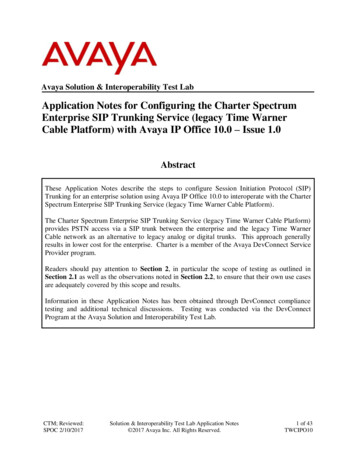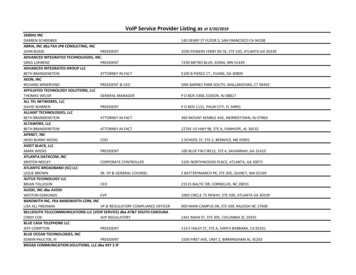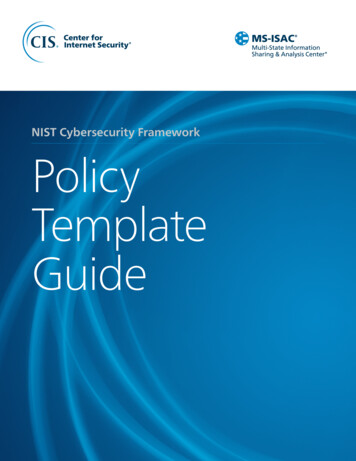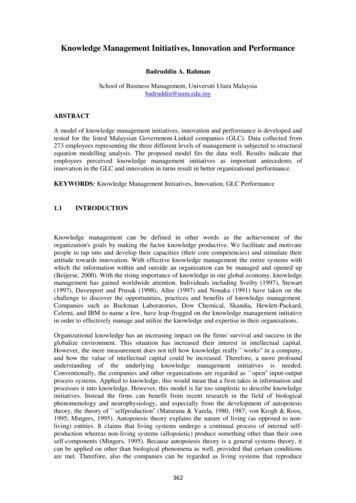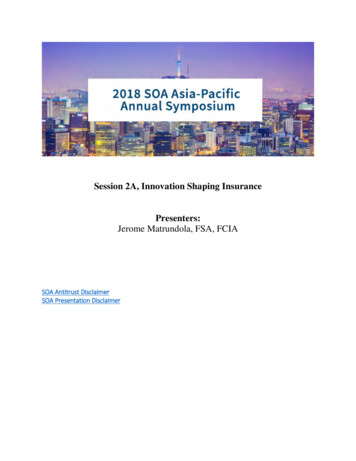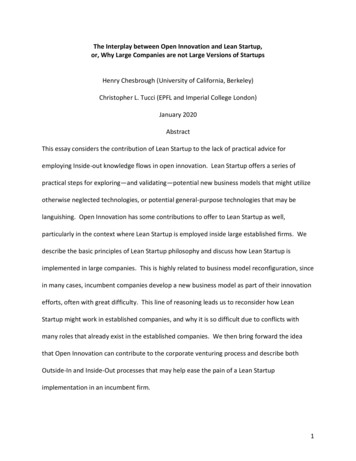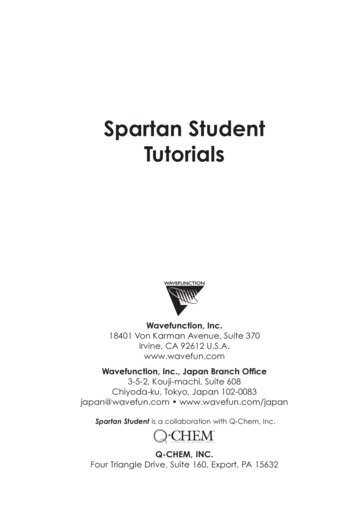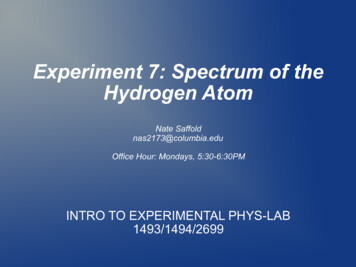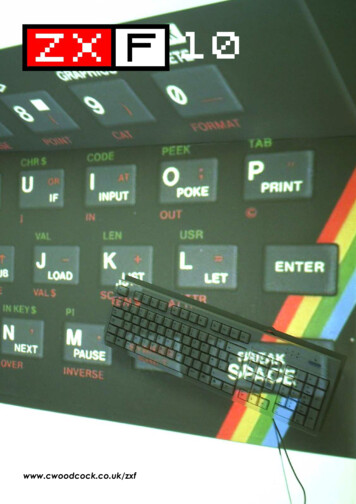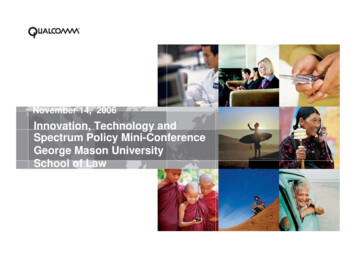
Transcription
Innovation, Technology and Spectrum PolicyGeorge Mason University School of Law, November 14, 2006November 14, 2006Innovation, Technology andSpectrum Policy Mini-ConferenceGeorge Mason UniversitySchool of Law1
Innovation, Technology and Spectrum PolicyGeorge Mason University School of Law, November 14, 2006LINKABIT – Founded October, 1968QUALCOMM - Founded July 1, 1985For Both Companies - No Products at StartStrategy – Innovation: Digital & Wireless Communications & Applications2
Innovation, Technology and Spectrum PolicyGeorge Mason University School of Law, November 14, 2006November 1989 – First CDMA DemonstrationTwo Base Stations (BTS) & “Mobile” PhonePhone Digital & AnalogBTS RFBTS Digital1 userPhone RF3
Innovation, Technology and Spectrum PolicyGeorge Mason University School of Law, November 14, 2006Nov. 1991: 3 Separate Chips Required for 2G CDMA Modem2006: 1 Chip Supports Multimode 3G/2G Modem & Much MoreSize Comparison (scaled to 90nm)120CDMAMicroProcessor(1or 50TV, DVRMMemory20SM6500Audio40MWLAN/PANCameraSM61003D GraphicsMDSP (2)4
Innovation, Technology and Spectrum PolicyGeorge Mason University School of Law, November 14, 2006Mobile Processing Power – Changing the Mobile DeviceSnapDragonConvergenceDual-CoreScorpion ARM 9Up to 2370 ARM9 ARM11Up to 740 MIPS*(400 MHz)1600MSM65501200Enhanced PlatformARM9Up to 250 MIPS*(225 MHz)MSM3000ARM7TDMI23 MIPS* (27 MHz)MSM6500MSM2800Intel 8018610 MIPS( 2.5 MHz)Multimedia PlatformARM9Up to 160 MIPS*(146 MHz)MSM2300ARM MCU 20 MIPS40001996* Dhrystone 2.11998200020022004200620085
Innovation, Technology and Spectrum PolicyGeorge Mason University School of Law, November 14, 20063G Broadband Technology EvolutionCDMA2000 Path – 1X uses 1.25 MHz SpectrumVoIPCDMA2000CDMA20001X1xEV-DODL: 153 kbpsUL: 153 kbpsDL: 2.4 MbpsUL: 153 kbps1X EV-DO1X – 15X EV-DORev ARev B1 1.25 - 20 MHz1DL: 3.1 MbpsUL: 1.8 MbpsDL: 3.1 - 73 MbpsUL: 1.8 - 27 Mbps2VoIPRev. C3Requirement:DL: 70 - 200 MbpsUL: 30 – 45 Mbps41.25 – 20 MHzWCDMA Path – 5 MHzRel-99Rel-5Rel-6WCDMAHSDPAHSUPADL: 384 kbpsUL: 384 kbpsCDMA2001CDMA/TDM2002OFDM2003VoIP2004DL: 7.2 MbpsUL: 384 kbpsDL: 7.2 MbpsUL: 5.8 MbpsRel-7Rel-8HSPA HSPA Phase 15Phase 25Target:DL: 40 MbpsUL: 10 MbpsOFDMA2005200620072008VoIPLTE6Requirement:DL: 100 MbpsUL: 50 Mbps2Note: timeline depicts initial commercial availability of each technology. Those introduced beyond 2008 are under standardization and are subject to variability1EV-DO Rev A and Rev B incorporate OFDM for multicastingData rates of 73 Mbps for the DL and 27 Mbps for the UL figures are based on a 2 x 20 MHz allocation3Will likely have multiple modes supporting FDD and TTD operation and utilizing a combination of OFDMA and CDMA; MIMO/SDMA; leverages EV-DO protocol stack4Data rate dependant on level of mobility. Data rates of 73 Mbps for the DL and 27 Mbps for the UL figures are based on a 2 x 20 MHz allocation5Release 7 and Release 8 introduce enhancements such as MIMO and VoIP6Utilizes OFDMA on the DL and SC-FDMA on the UL; MIMO26
Innovation, Technology and Spectrum PolicyGeorge Mason University School of Law, November 14, 20063G Offers Many Embedded Solutions TodaySeptember September20062005074Commercial Notebooks010Notebook manufacturers0113G Embedded Carriers7All trademarks, names of other companies, logos, products and services are the property of their respective owners
Innovation, Technology and Spectrum PolicyGeorge Mason University School of Law, November 14, 2006Today’s 3G Technologies Outperform Mobile WiMAXForward Link Sector Throughput ComparisonEffective Physical Layer Throughput per Sector in 10MHz12Mbps1086420Mobile WiMAXMbps/sector 4.5DOrADOrB4,5008.965MHz10.5HSPA 10.4Simulation assumptions:SIMO Full Buffer, physical layer performance3GPP2 frame workDV channel model mixEqualizer gain simulated for DOrA, DOrB and HSPA 10MHz TDD 2:1 carrier for Mobile WiMAX, scaled to 10MHz effective Forward Link85MHz FDD carrier for HSPA , 2 carriers in 2x10MHz. 1.25MHz FDD carrier for DOrA and DOrB, 7 carriers in2x10MHz
Innovation, Technology and Spectrum PolicyGeorge Mason University School of Law, November 14, 2006Wireless Voice over Internet Protocol (VoIP)Packet-Switched Voice on EV-DO Rev A, Later on HSPA DOrA VoIP Tested in Loaded Wide Area Network Result: 60 to 70 High Quality VoIP calls per Sector in 1.25 MHz 30-35 times more efficient than 1G Analog Advanced techniques ensure quality comparable or better thancircuit-switched voice services Utilize Quality of Service (QoS), advanced hand-off algorithms, mobile Rxdiversity, Equalizer, and other enhancementsLow-Latency Enables Fast-Response Push-to-Talk & Push-to-Media Networks9
Innovation, Technology and Spectrum PolicyGeorge Mason University School of Law, November 14, 20061 Billion People Estimated To Have Access to Over 118 3G MobileBroadband Networks by End of Calendar 200650 Million Mobile Broadband Subscribers Estimated by End 2006EV-DO: 51 Commercial OperatorsHSDPA: 25 Commercial Operators*Source: 3Gtoday.com as of November 2006: 1xEV-DO: 51 operators and HSDPA: 25 operators. 1 billion refers to combined estimated POPscoverage.10
Innovation, Technology and Spectrum PolicyGeorge Mason University School of Law, November 14, 20063G Shipments to Surpass All Others Before 2010Increasing Network and Device Capabilities at Reduced CostsGlobal Device Sales 03G surpassesnon-3G in obile Phones (total)20042005200620073G Mobile Phones200820092010Non-3G Mobile Phones11Source: Average of Strategy Analytics (Sep 2006) and Yankee Group (Aug 2006) handset forecasts
Innovation, Technology and Spectrum PolicyGeorge Mason University School of Law, November 14, 20062G to 3G Migration in 000Mar'Ju 01n'Se 01p'D 01ec'M 01ar'Ju 02n'Se 0 2p'D 02ec'M 02ar'Ju 03n'S e 03p'D 03ec'M 03ar'Ju 04n'Se 0 4p'D 04ec'M 04ar'Ju 05n'Se 05p'D 05ec'M 05ar'Ju 06n'Se 06p'06-Source: TCA2G3G CDMA12
Innovation, Technology and Spectrum PolicyGeorge Mason University School of Law, November 14, 2006Dec2003Mar2006100%70%GSM75%50%2004-2005:WCDMA Grew 144%GSM Declined 8%30%WCDMA25%0%Dec'03 Mar'04 Jun'04 Sep'04 Dec'04 Mar'05 Jun'05 Sep'05 Dec'05 Mar'06WCDMAGSMWCDMA and GSM % of Handset Shipments in W. Europe13GSM Source: Yankee Group; WCDMA Source: QUALCOMM estimate
Innovation, Technology and Spectrum PolicyGeorge Mason University School of Law, November 14, 2006WCDMA Handset Revenue Higher Than GSM in Western EuropeWCDMA 62% of handsetrevenue in June qtr100%62%WCDMA75%50%38%GSM25%0%Dec'03Mar'04Jun'04 Sep'04 Dec'04Mar'05WCDMAJun'05 Sep'05 Dec'05Mar'06Jun'06GSM14GSM Source: Strategy Analytics & Yankee Group; WCDMA Source: QUALCOMM estimate
Innovation, Technology and Spectrum PolicyGeorge Mason University School of Law, November 14, 2006CDMA and WCDMA Subscribers Accelerate in North AmericaNorth America Wireless Technology Market 30%20%10%0%20062007200820092010* “Other” includes AMPS, cdmaOne, iDEN and TDMASource: Average of Strategy Analytics (January 2006) and Yankee Group (March 2006) subscriber forecasts15
Innovation, Technology and Spectrum PolicyGeorge Mason University School of Law, November 14, 2006Licensed Spectrum: Rapid Increase of 3G Wireless Broadband Verizon Wireless EV-DO network is available to 150 million people inmore than 170 cities in the U.S. today. Services enabled by this networkinclude “Broadband Access,” “V-CAST,” “Get-it-Now,” and “VZNavigator.” Cingular’s HSDPA network is available to 35 million people in 52communities and is expanding to all major markets by the end of thisyear. Services enabled by this network include “Cingular eBayWireless,” “Broadband Connect,” and “HBO Mobile.” Sprint Nextel has launched EV-DO Rev A in First Markets; coverage toreach more than 40M people by end of year . Services enabled bythis network include “Sprint TV,” “Sprint Mobile Broadband,” “SprintPrecision Locator”, and Nextel-style Push-to-Talk in 08. All Carriers Next Generation Network Technologies (EV-DO and HSDPA) 1are available in counties containing 63% and 20% of the U.S. population,respectively.1.FCC Eleventh Annual CMRS Competition Report, September 26, 2006.16
Innovation, Technology and Spectrum PolicyGeorge Mason University School of Law, November 14, 2006Convergence of Consumer Electronics & CellphonesWalkie-TalkieVoicePDAPhoto AlbumTelevisionCamcorderGlucometerCameraWalletFM RadioBar ScannerGame ConsolePCMP3 PlayerNewspaperGPS DeviceRolodexPager17
Innovation, Technology and Spectrum PolicyGeorge Mason University School of Law, November 14, 2006Location-Based Services Rapidly ExpandingToday, gpsOne enables:Nearly 200 millionhandsetsPoints ofInterestPeer to PeerCommerce50 carrierdeployments40 handsetmanufacturersSecurityGamingE911 Services18
Innovation, Technology and Spectrum PolicyGeorge Mason University School of Law, November 14, 2006Diabetes Phone:Glucometer cell phone &service for managingdiabetes remotely19
Innovation, Technology and Spectrum PolicyGeorge Mason University School of Law, November 14, 2006CardioNet: Cardiac Monitoring Service -Enabled by QUALCOMM’s Wireless Network Management Services20
Innovation, Technology and Spectrum PolicyGeorge Mason University School of Law, November 14, 2006Downloading Applications to Very Low End Phones in India TATA among Top-10 for BREW download revenue Application download doubled between May and June2006, 2/3rd contributed by Kyocera Prisma 80% of new BREW users on CDMA Prisma in June 2006Wallpaper DownloadGames DownloadRing Tone Download21Source: Sino-MR, as of Jun 2006
Innovation, Technology and Spectrum PolicyGeorge Mason University School of Law, November 14, 2006Interest in Video Outstrips Other Cell Phone Features7xPrefer VideoPrefer OtherVideo Preference Multiple80%P reference S 2x1x10%0%V ideo P reference M ultiple90%0xCameraInternetPush to TalkIMGamesVideo functionality second only to voice 1.5 to 1 preference for video services over camera phone 2.3 to 1 preference for video services over push-to-talkSource: Consumer Preference Index Video vs. Alternate Features; Primary research results conducted by Spear &Associates, sample of 2,800 cell phone and cable users & nationwide focus groups22
Innovation, Technology and Spectrum PolicyGeorge Mason University School of Law, November 14, 2006MediaFLO - Integrated Service Across Multiple NetworksLow Cost Multiple Channels to Mobile DeviceNon-real-time clip-casting OFDM FLO networkMediaFLO MDSContentProviders(Shared Content)Managed by FLOOperatorFLONetworkUHF Channel 55MediaFLO ClientContentProviders(Unique Content)MediaFLO MDSManaged byWireless OperatorVOD Services & Authentication3GNetworkWCDMA or CDMA2000 3G network23
Innovation, Technology and Spectrum PolicyGeorge Mason University School of Law, November 14, 2006MediaFLO - Superior User Experience and Economics Over 25 real-time TV channels andstreaming audio channels Including Clipcast content andnumerous IP datacast services QVGA resolution at up to 30 fps 1-2 second channel changing time Optimized power consumption24
Innovation, Technology and Spectrum PolicyGeorge Mason University School of Law, November 14, 2006Networks: Richer Information Distribution PossibilitiesLive Stock Quotes & Game StatsVideo / AudioWeatherGamecastingData Channels / RSSStock TickerTraffic25
Innovation, Technology and Spectrum PolicyGeorge Mason University School of Law, November 14, 2006FLO Now a Standard: Published as TIA-1099 with Support of Global FLO ForumPromotes global standardization of FLOtechnology & the development andcertification of FLO products and servicesSupports global efforts for acquisition andclearing of spectrum for FLO deploymentsBy wireless value chain By geographySemiconductor (8)Devices (10)Infrastructure (36)Content Owners (1)FLO Service Providers (1)Wireless (3G) Service Providers (4)Academic Institution/Research &Development (2) USA (22)Canada (1)China (5)Korea (13)Japan (5)Israel (1)Europe (15)62 members from 12 countries Representing all levels of the value chain26For the latest listing of FLO Forum members, please see www.floforum.org
Innovation, Technology and Spectrum PolicyGeorge Mason University School of Law, November 14, 2006MediaFLO USA Preparing for Launch, 1Q 2007MediaFLO Network Operations Center (NOC) – San Diego, CA27
Innovation, Technology and Spectrum PolicyGeorge Mason University School of Law, November 14, 20064 Times Square, New York City28
Innovation, Technology and Spectrum PolicyGeorge Mason University School of Law, November 14, 2006MediaFLO OEM Phones Shown at CTIA Show, March 200629
Innovation, Technology and Spectrum PolicyGeorge Mason University School of Law, November 14, 2006Licensed Spectrum for Wide Area Networks Interference More Easily Managed Identification and elimination of interference sources easier whenthe operator of the interfering systems is known Licensees have strong incentives to promote efficient use ofspectrum Investment Encouraged Certainty provided by an exclusive license attracts private capital Without certainty, infrastructure investment will lag Wireless carriers have invested 199B in their networks and arecontinuing to upgrade to achieve higher speeds and expandedservice offerings30
Innovation, Technology and Spectrum PolicyGeorge Mason University School of Law, November 14, 2006Unlicensed Spectrum for Local & Personal AreaNetworks Unlicensed Services Are a Useful Complement to Licensed Services Unlicensed ideal for short-range applications including wireless LANs(e.g. WiFi), PANs (e.g. Bluetooth & UWB) and cordless phones Unlicensed spectrum can offload traffic from licensed spectrum, freeingthat spectrum for longer-range uses Interference in short-range systems can often be managed with theinterfering and interfered-with systems controlled by one person Since unlicensed spectrum is best suited for short range WLAN and PANuses, the higher-frequency regions of the spectrum (e.g. 2.5 GHz) arewell-suited for unlicensed use, increasingly with MIMO31
Innovation, Technology and Spectrum PolicyGeorge Mason University School of Law, November 14, 2006Network EvolutionCommon All-IP Core Network Supporting Multiple Air Interfaces Selection of access based on service requirements, availability, cost Full range of devices access the same content across different IP networks32
Innovation, Technology and Spectrum PolicyGeorge Mason University School of Law, November 14, 2006Spectrum Policy Should Aim to Achievethe Most Efficient Use of a Scarce Resource Auctions are proven to be an efficient means of allocating scarceresources. The FCC just completed its largest and most successfulauction ever, raising over 13B for the U.S. Treasury. The predominant method of wireless access to the internet is and willcontinue to be over wide area networks in licensed spectrum. The lower regions of the spectrum are best suited for licensed services. Licensed services can best take advantage of the propagation characteristics ofthe lower frequencies, and attract the necessary capital to drive innovation andnetwork expansion. Allocations of prime spectrum below 700 MHz to unlicensed useencourage overuse of this spectrum. There are no incentives to use unlicensed spectrum as efficiently as possible.33
Innovation, Technology and Spectrum PolicyGeorge Mason University School of Law, November 14, 2006TV “White Spaces” Should be Auctioned This is very valuable spectrum, with excellentpropagation characteristics. The best way to take advantage of these uniquepropagation characteristics is to maximize powerwhile controlling for interference. This combination of high power and excellentpropagation could be especially useful in ruralareas. If allocated to unlicensed use, power levels willneed to be limited to control for interference.Cont 34
Innovation, Technology and Spectrum PolicyGeorge Mason University School of Law, November 14, 2006TV “White Spaces” Should be AuctionedCont . Proposals to make this spectrum available prior tothe DTV Transition are jumping the gun. The Digital TV Transition should proceed accordingto current schedules, as the FCC recently stated inits NPRM. Licensing the white space will facilitate a transitionaway from over-the-air TV to more efficient uses ofthe TV spectrum.35
Innovation, Technology and Spectrum PolicyGeorge Mason University School of Law, November 14, 2006Promises of Muni WiFi Systems are Often Exaggerated Muni WiFi has been claimed as the solution to: Public safety communications needs Broadband last-mile connectivity Last resort communications during natural disasters The jury is out on cost & performance e.g. “WiFi Outlook Cloudy in Mountain View”http://unstrung.com/document.asp?doc id 109919&WT.svl news2 2 Unresolved issues include: Coverage limitations and service qualityManaging interferenceCapital & Operating CostsSustainability of long-term business case. The risk to spectrum policy: Muni WiFi advocates seek additional unlicensedspectrum allocations to reduce interference, which, if granted, could deprivethe public of the highest and best use of the spectrum36
Innovation, Technology and Spectrum PolicyGeorge Mason University School of Law, November 14, 200637
Innovation, Technology and Spectrum PolicyGeorge Mason University School of Law, November 14, 2006Clinica Kausay Wasi, PeruEmpowering Citizens Globally by Providing WirelessConnectivity to Remote Medical Clinics The clinic coordinated with NorthwestMedical Teams to bring physicians whovolunteer to serve impoverished residentsthat have no access to healthcare As of March 2006, over 3,000 residents havereceived medical attention With CDMA wireless connectivity, the cliniccan now communicate with medicalprofessionals from all over the world38
Innovation, Technology and Spectrum PolicyGeorge Mason University School of Law, November 14, 2006Wireless Reach MexicoEmpowering Citizens Globally by Providing Wireless Connectivityto Enable Microfinance for Remote Areas Integrate technical and policyexpertise Building both individual andinstitutional capacity in theformation of highly skilledMexican telecommunicationsand development policyprofessionals39
Innovation, Technology and Spectrum PolicyGeorge Mason University School of Law, November 14, 2006Digital Education Pilot Project in Brazil3G Wireless Broadband Access with CDMA2000 1x EVDO @ 450 MHzPartnership between Lucent, Anatel (Brazil’s regulatory agency) and otherorganizaitons to demonstrate CDMA2000 1xEV-DO broadband data capabilities andcoverage at lower frequencies for universal broadband access (2004).40
Innovation, Technology and Spectrum PolicyGeorge Mason University School of Law, November 14, 2006Thank You.41
Nov 14, 2006 · George Mason University School of Law, November 14, 2006 1 Innovation, Technology and . sample of 2,800 cell phone and cable users & nationwide focus groups Interes

